Hardening off young tender plants so they can withstand the heat, wind, rain and cold swings of Spring is the most important thing you can do before transplanting seedlings to your outdoor garden, particularly if you started your plants indoors.
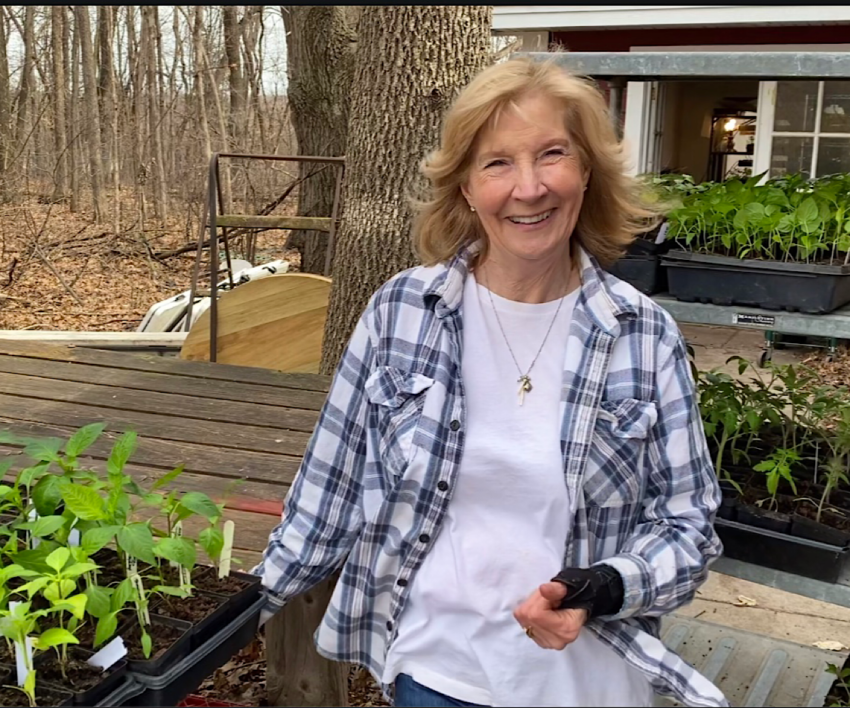
Jump to: Step by Step for Transplanting Seedlings Outdoors | Pro Tips | Troubleshooting | Video
This post may contain affiliate links. As an Amazon Associate, I also earn from qualifying purchases. You can read our disclosure information here–
For me, hardening off young plants is a difficult task because I grow so many of them for sale at the farmers’ markets, and it is therefore difficult to give them the individual attention they would love.
For the home gardener with fewer seedlings, the step by step process would go like this:
Step-by-Step for Transplanting Tomato and Pepper Seedlings
Step #1: When to start hardening off:
Depending on the weather, start exposing your seedlings to the outdoors around 3-4 weeks after they have germinated and have at least one set of leaves beyond their seed leaves (seed leaves are those skinny smooth leaves that come up first at germination and generally fall off after the plant has matured a bit);
Prior to hardening off seedlings they should be potted up from tiny cells into larger pots (I like 4” pots). If you live in a climate where a late frost or cold winds could damage your seedlings, check out these detailed steps on potting up tomatoes.
Step #2: Gradual Exposure to Sunlight and Wind
- on their first day outdoors, go slow and cool. Do NOT put them out in direct sunlight on their first day out and do NOT put them out on a windy day. Direct sun or wind (warm or cold wind) will do a lot of damage and really set them back. Ideally you would have a shady spot with dappled sunlight and you would put them out for a few hours in this spot (morning or afternoon is fine as long as the spot is semi-shady and the weather is still;
- Bring them back in after a few hours. There is no set time here, as it depends entirely on what the weather is like that day, how far along your seedlings are, and what their inside growing conditions have been. Just check them every hour or so and if they are looking sad or wilted, bring them back in;
- Repeat these steps for a few days, gradually giving them more sun and more time outside;
- It usually takes about 5-8 days to get the tomato and pepper seedlings fully hardened off. If you do it gradually and add more sun to the hardening off area each day, they should be able to take full sun, rain and gentle winds after this. Hail and strong cold winds however, will probably damage your plants, no matter how careful you have been in hardening them off.
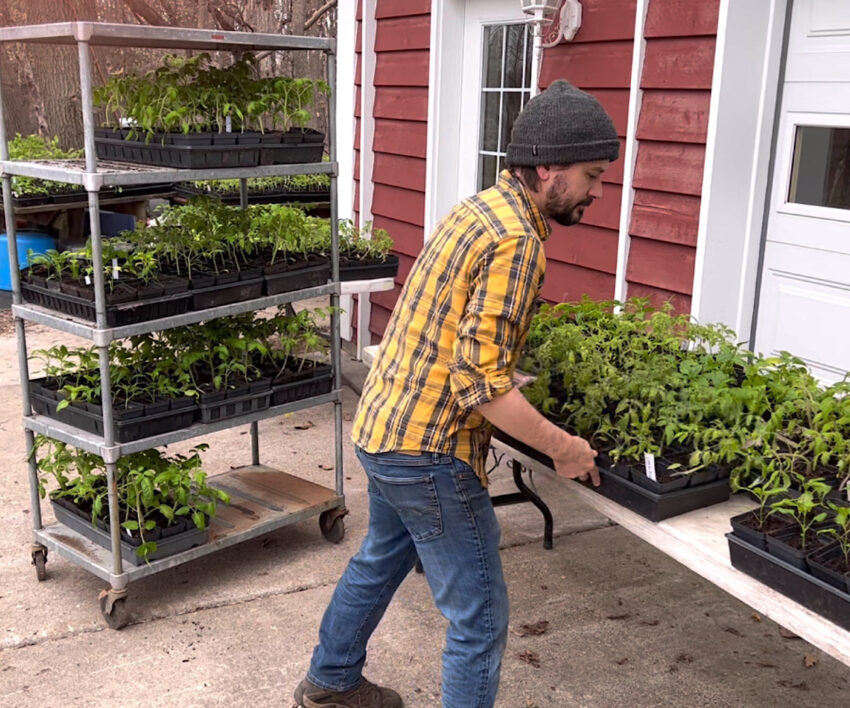
Tips for Preparing Tomato Seedlings for Transplanting Outdoors:
- make sure they are watered before you put them out. The weather is harsh on these young seedlings and they need to be babied for a few days;
- it helps if you open a door or window and let cool air and breeze into the growing room before you take them out (not absolutely necessary, but it helps);
- Don’t keep your seedlings on the ground if they are out for any length of time. Rabbits, voles and mice love the tender growth and will be quick to eat them while you’re away.
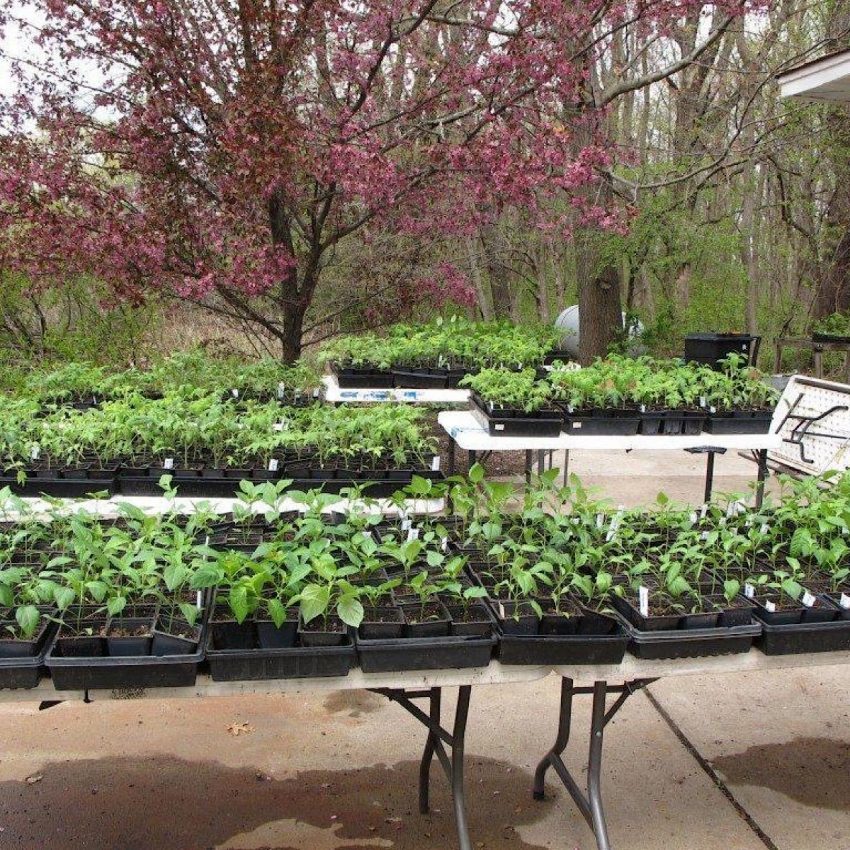
Step #3: Transplanting Tomato Seedlings Outdoors
If the steps listed above are followed, it should take about 5-7 days before seedling can be safely planted outside. This is going to depend on the weather during those 5-7 days and how strong the seedlings were prior to hardening off.
Many vegetables are vining plants or large plants (pole beans, tomatoes & peppers, etc.) and will need some sort of support. It is a good idea to get your support system in the ground (or pot) shortly after transplanting outside while they are still small plants. Here’s a detailed post on cages vs stakes vs trellis system.
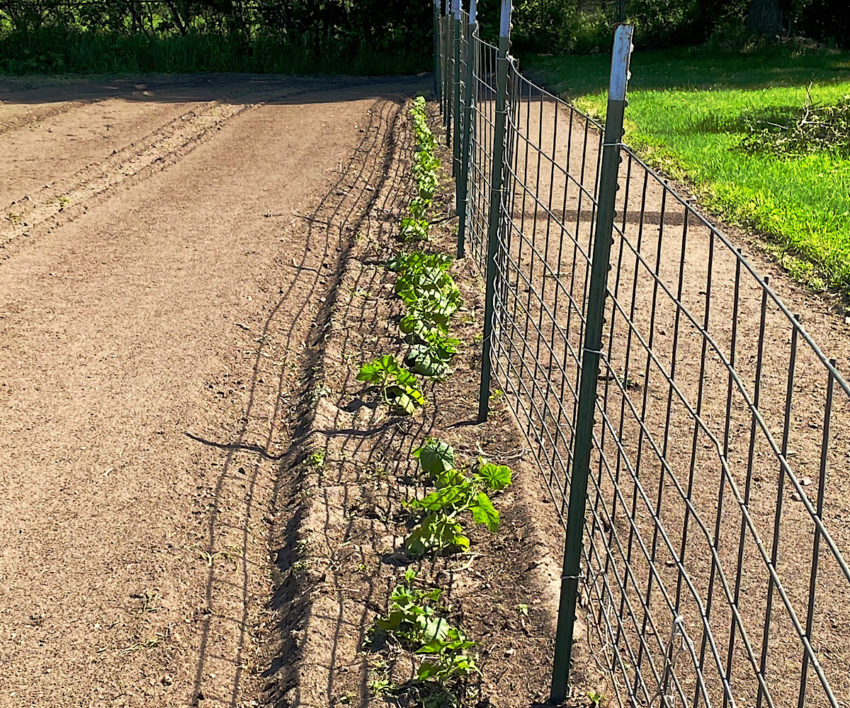
Trouble Shooting Problems in Hardening Off Stage:
- Tomato plants are often stronger than you think, so don’t completely despair if something goes wrong. I have had my tomato and pepper seedlings decimated in hailstorms, put them aside to compost them, and then be amazed to see them come back stronger and greener than before (no guarantees, but don’t be too quick to toss them);
- If your plants are exposed to sun too early or for too long they may get sunburned and the leaves will look more of a pale yellow color rather than a dark lush green. They are probably OK. Just look at the new growth and if it looks good, your sunburned leaves will not affect your plant or its fruit as it matures.;
- If the weather is bad for a good part of the spring and you can’t get your seedlings into the ground to start growing, you can fertilize them with some kind of nitrogen-rich foliar spray (seaweed, fish emulsion or something like that). Just make sure they have been potted up to larger pots before fertilizing.
Guides for successfully growing tomatoes
- For germinating seed indoors
- Growing tomatoes in pots
- Best seed catalogs for tomatoes
- Best trellis systems for tomatoes
- Season extension for tomatoes
- Taste of heirloom tomatoes based on color
If you like my articles about cooking and gardening, subscribe to my weekly newsletter, where I share free recipes and gardening tutorials.

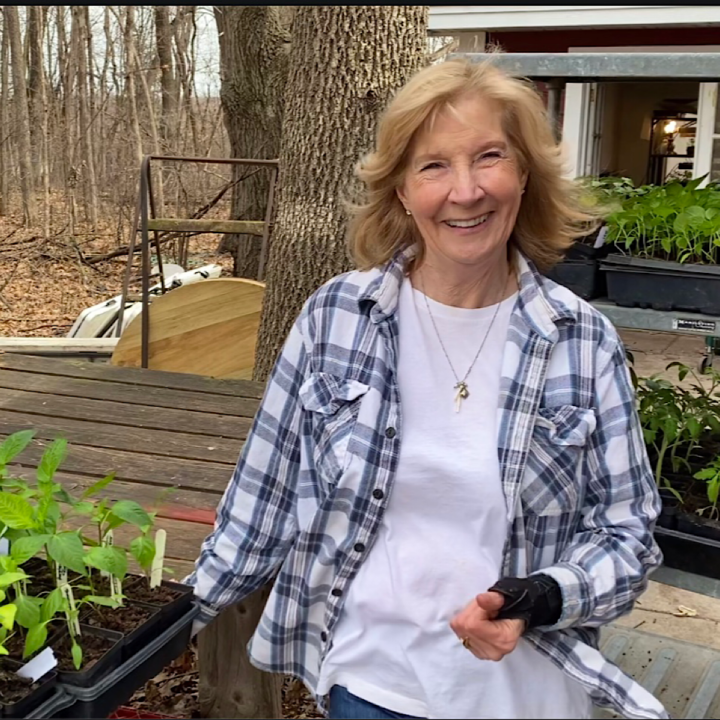
Nice article and I found it interesting. I usually run into problems with hardening them off due to work. Either I worked too long during the day and could not get home faster enough to get them back indoors or working nights and sleeping days…have to win a lottery so I can retire 🙂
I know Tim. My biggest problem is getting them in and out quickly with our dramatic spring weather. Wind, hail and blazing sun are common in the spring and you never know which one you’ll get. Not a problem if you only have a few starts, but with the hundreds that we have, it can be really difficult. Wind has been the biggest problem actually — it dries them out and wilts them very quickly.
Very helpful article. Last weekend I goofed and thought I had my pepper plants hardened off good enough. It was warm and windy, and a few got sun/wind burn. They have recovered as I put them in the shade and out of the wind, then brought them inside because of a freeze. Article helped me figure the process out—
So glad it helped a bit Dave. Believe me, anything I know is from doing it wrong too many times first!
Thanx. I have 30 pepper plants going—my family likes the hot ones–Ghost, Scorpion, Thai red—
One question, when to fertilize the pepper seedlings? I have some Peters 20/20/20 used at half strength at about 2-4 weeks. Sound ok?
Dave, I don’t know much about the commercial fertilizers as I just use compost (aged horse manure) on the farm. I do know that the hot peppers are hotter when they are more stessed (i.e., not a lot of nutrients), but the sweet bell peppers thrive with compost and seem to like a bit more nutrition than the hot. It depends on what potting soil they were in to begin with. I pot my seedlings up into 4″ pots filled with Miracle Grow potting soil and that sustains them until they go into the ground at about 8 weeks old. The soil has compost tilled in and that lasts all summer. Just be careful not to give them too much nitrogen or they will have beautiful leaves and not many peppers.
Yes, I’m aware the to much Nitrogen will do that. I have all mine in containers, plus I do have some organic 4-6-2 fertilizer. I can use compost when I put them in larger pots once they get larger. Thanx again—
I have grown tomatoes and peppers for many years and normally use the method of hardening mentioned above with great success, it is a hard and long job as I grow a lot of these plants and my area for hardening of is quite a long way from the house where they germinate, so for the last two years I have tried a different method, once repotted into individual pots, and given a little time to recover from repotting I move them to the polytunnel, but keep very shaded and cool, and warm at night, after a cold but frost free night the plants look fine, but an hour later they are all flopping over, and some leaves dye of, they do recover after some TLC but are set back, any ideas how to stop this and why does it happen? Just as a matter of interest the plants are on top of a hot bed for warmth, maybe it is the change in temperature they don’t like, or the gas from the hot bed,there is a plastic sheet between the plants and the hot bed, and it is only warm not hot, any thoughts please.
Terry Scates
Hi Terry, I have had that experience before also when I tried to harden plants off too quickly. For me it was the duration of the change in temperature. If I tried to hurry the process and kept the plants outside in shaded area for too long the first few days, they would recover at night in the garage, but flop over as soon as they were exposed to warmth and outside. So, I don’t know for sure but my guess is the change in temperature and conditions from the house to the tunnel is too rapid and it has to be done in stages to fully acclimate them. I doubt it is due to the gas.
Hi Dorothy, thanks for your comments, yes, I think that must be the case, it could be the rapid rise in temperature between the night and when the sun gets on the tunnel in the morning, even though the plants are well shaded and the doors open, the rise is from as little as 3c to 20c in about 30 minutes,
Terry
I did not know that hardening off plants could be done at such an early stage. Thank you so much for sharing your expertise. Your advice was very very helpful.
@Dorothy Stainbrook, it won’t be over 50 here at until at least June. At night here it’s still in the high 30s. Some days in 70s. My plants are big.. ( at least 8-10”) even though I just started them in April. I haven’t even considered hardening them yet as e we have frost advisories until late may here. Should I wait to start hardening in late may? My plants will be HUGE by then. I’ve actually been fertilizing since day one, as they were started in water systems where there is always fertilizer.
I would take them out in the daytime if the temps are over 40 and just keep an eye on them. Make sure they are watered as they dry out a lot faster outdoors. I would bring them in at night if the temps are going to go below 35. They are probably that big because you are fertilizing them. What you want is sturdy stems and no flowers. If they have started flowering you will still get tomatoes, but not as many. Over fertilizing will give you nice green leaves and fewer fruits, so back off on the fertilizing if possible.
You bet Pat. Just remember to go slow-w-w. Wind is enemy number one. Direct sun enemy number two. Temperatures below 50 enemy number 3
do you apply water regularly to seedlings at hardening stage?
Yes, you need to water daily at hardening stage. They dry out much quicker when outside so you really need to watch them and make sure they stay watered.
[…] leaving them there. In direct sunlight. In wind. In wild, pouring rain. Apparently (if you actually research, which I clearly didn’t), this is supposed to be a very gentle process that takes about a […]
Great information. Thank you. Wish I had read it a week sooner. Tomatoes got ‘ sun burned’ as did cukes ( started them from seed a little too early). Tomatoes are surviving. The jury is still out on the cukes. Keeping my fingers crossed.
I am wondering if you put them back under grow lights when you bring them inside? How many hours of light per day are they getting?
Amy, that part is an art rather than a science. Once they are hardened off I don’t use the grow lights any more. If they aren’t quite there yet I may continue with the grow lights until they are strong enough. They’re averaging around 15 hours of light.
Amazing advice. I’m so glad I clicked on this link. I’m a newbie at growing and am growing Trinidad moruga Scorpion peppers on my balcony. Slight sunburn today on one of them. This article answered all of my questions for now. I’ll definately check back for more info. Thank you. 🙂
Hi my tomatoes seedling have just germinated and their one week old and they have started fally down some breaking at the middle please I need help.
I had that happen once years ago it may mean the root system and stem is not deep enough you could try putting the entire pod or fiber pot in something bigger and deeper and make sure you the stem buried deep
I made the mistake of not reading this before I put all of my pepper and tomato plants outside and we had a windy day (21mph] I had been told by a farmer to get them into the wind but now I read your article and I am afraid they look fine so far but I am worried my plants are about 8″ tall and have at least 3 branch offs. The weather has been cold so this is the first real chance I had to do this.
Thanks, great article!
So I left my pepper plants out side for too long hardening then and the leaves got extremely sun burnt what can I do that could help bring them back? They are about 2/3 months old now
I’m in Seattle and fairly new here. I don’t quite understand the weather patterns here other than it rains a lot in the winter… I started some peppers and tomatoes in the house last week but now I’m afraid it was much too soon. If they get too big before its gets warm enough, what do i do? I’m a little worried…
Thanks for the information. I am in the process of hardening off some tomato and chili pepper plants. I have a question about mature plants: I have a habanero plant that was started from seed last spring that I planted in a 20″ pot. It thrived and did great. It grew to about 3 feet tall. At the end of the season, I moved it into a heated garage that I kept between 55 and 60 F through the winter. I also kept a grow light on it about 12-14 hours per day. It isn’t super healthy, but it continued to produce peppers all winter long. (Somewhat stunted peppers, but still hot as can be!). My question is, do I need to re-harden this 1 year old plant before putting it out full time this Spring? It is been indoors for about the last 5 months or so, and it has some yellowing or spotted leaves. I gave it some bone meal and fertilizer recently and started setting it outdoors recently with my new peppers and tomatoes, and it seems to be getting healthy again. Just didn’t know if re-hardening was necessary.
I really appreciate this help, but as a new gardener, I still feel like I need some guidance. How long do you take for this process? Do you lengthen the time they are outside? How gradually? When do you move them into wind/sun? How do you know they are ready to plant?
Shannon, I have updated the post to make it more of a step-by-step. Hopefully this answers all of your questions.
I love the first photo – how many seedlings! It’s really impressive! When I came across gardening blogs it makes me really motivated and passionate about plants. Your tutorial seems very helpful, especially for me. I don’t grow so many plants so your step-by-step list will be used by me while seedlings hardening off. [I have already made a list!] so I will comply to your tips.
Thank you for commenting Dobbia! Best of luck…..start small!
When hardening off, do they go back under grow light when not outside, or is it ok to just bring inside, in room with regular light (or light off for part of day?).
It kindof depends on how big they are. Most of mine I just bring back into the shop without the lights on them. It helps if you bring them in to a fairly cool place also (like around 55-60 degrees). If they are pretty small and look a little fragile, they may need to go back under the lights for a bit.
So happy you found it useful Alice. I’m coming your way in February. Can’t wait to visit Australia!
So glad it was helpful to you! I try to update once a week. It’s good to let me know expectations to keep my feet to the flame (I think that’s the saying?).